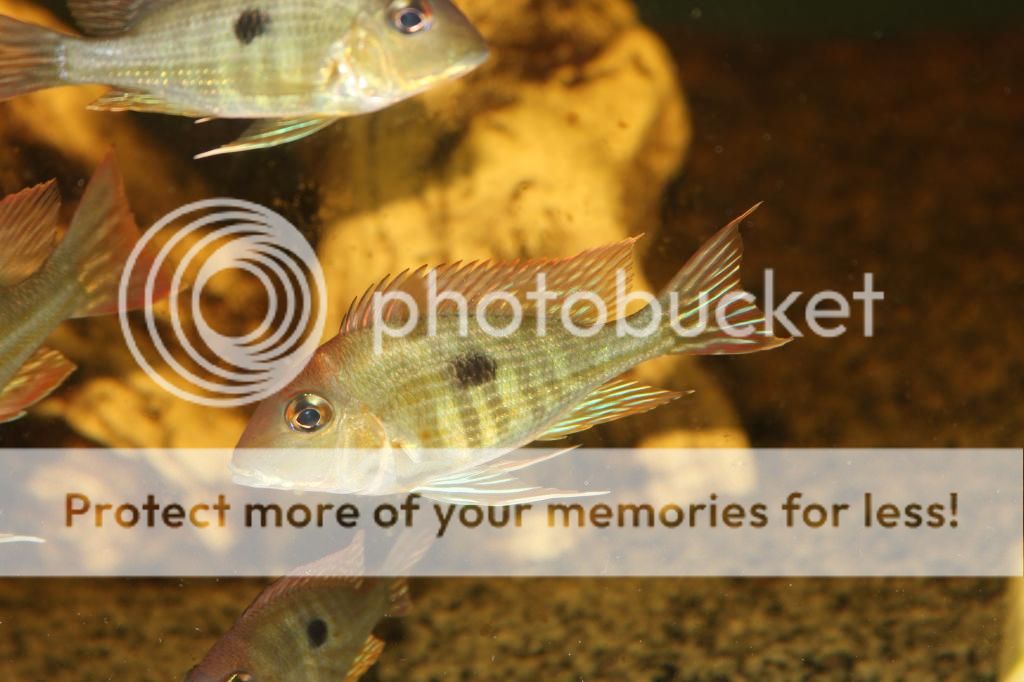This is only here to be later moved to the fish species index. Thanks

Common name/s: Geophagus Red Head Tapajo
Scientific name: Geophagus sp. 'orange head'
Family: Cichlidae
Origin: South America
Maximum size: 5-6” (12-15cm)
pH: 4.5-7.5
Water temperature: 76-86f (24-30C)
Care: A sand substrate is required, they forage through the sand for food, they don’t usually find food but they do it constantly. Coarser materials such as gravel or small pebbles can inhibit feeding, damage gill filaments and even be ingested with the potential of internal damage or blockages. A 55 gallon should be the minimum tank size for a group of 5-8 to form a natural hierarchy. Decorations should be chosen carefully they will dig around EVERYTHING in the aquarium including plants so these aren’t best for the planted aquarium. Excess maintenance is needed as these fish are very sensitive to deteriorating water conditions, you should also have mechanical filtration to catch floating debris. Weekly water changes of about 50-75% should be performed. Peaceful unless breeding, they will protect their young, best avoid aggressive bottom dwelling species.
Feeding: The Tapajos is an omnivore that generally feeds from the bottom of the aquarium (but will surface for frozen bloodworms) and should be fed a variety of foods, such as live, prepared, frozen or freeze-dried: brine shrimp, bloodworms, blackworms, krill, flake food, and soft, sinking, Cichlid pellets. Mine go all over the levels of the aquarium for food, the food doesn’t even need to be on the floor for any of my geophagus actually.
Sexing: Males are more intensely-coloured than females, tend to be a little larger and develop longer fin extensions. Some dominant individuals develop a nuchal hump as they mature.
Breeding: Tapajos are brood caring, mouth brooders and breeding them is not too difficult. Breeding can be induced by feeding them plenty of live and frozen foods that are high in protein, raising the water temperature to 86° F and lowering the pH levels with peat (can be added as filter media). The female Tapajos will lay around 300 eggs in a carefully cleaned, flat location (driftwood, flat rock/stone, slate, or large plant leaves) and within 1-24 hours, will transfer the eggs to her mouth and care for them until they hatch. The parents will dig pits in the sand to shelter the fry in during the day and will transfer them to their mouths at night. After 2-3 weeks the fry are free-swimming, but the parents will still allow themselves to be used for shelter until the fry are too large to fit in their mouths. The fry can be fed a diet of baby brine shrimp or crushed flake food and then be moved to other foods as they mature.
Pictures of my youngins.



Common name/s: Geophagus Red Head Tapajo
Scientific name: Geophagus sp. 'orange head'
Family: Cichlidae
Origin: South America
Maximum size: 5-6” (12-15cm)
pH: 4.5-7.5
Water temperature: 76-86f (24-30C)
Care: A sand substrate is required, they forage through the sand for food, they don’t usually find food but they do it constantly. Coarser materials such as gravel or small pebbles can inhibit feeding, damage gill filaments and even be ingested with the potential of internal damage or blockages. A 55 gallon should be the minimum tank size for a group of 5-8 to form a natural hierarchy. Decorations should be chosen carefully they will dig around EVERYTHING in the aquarium including plants so these aren’t best for the planted aquarium. Excess maintenance is needed as these fish are very sensitive to deteriorating water conditions, you should also have mechanical filtration to catch floating debris. Weekly water changes of about 50-75% should be performed. Peaceful unless breeding, they will protect their young, best avoid aggressive bottom dwelling species.
Feeding: The Tapajos is an omnivore that generally feeds from the bottom of the aquarium (but will surface for frozen bloodworms) and should be fed a variety of foods, such as live, prepared, frozen or freeze-dried: brine shrimp, bloodworms, blackworms, krill, flake food, and soft, sinking, Cichlid pellets. Mine go all over the levels of the aquarium for food, the food doesn’t even need to be on the floor for any of my geophagus actually.
Sexing: Males are more intensely-coloured than females, tend to be a little larger and develop longer fin extensions. Some dominant individuals develop a nuchal hump as they mature.
Breeding: Tapajos are brood caring, mouth brooders and breeding them is not too difficult. Breeding can be induced by feeding them plenty of live and frozen foods that are high in protein, raising the water temperature to 86° F and lowering the pH levels with peat (can be added as filter media). The female Tapajos will lay around 300 eggs in a carefully cleaned, flat location (driftwood, flat rock/stone, slate, or large plant leaves) and within 1-24 hours, will transfer the eggs to her mouth and care for them until they hatch. The parents will dig pits in the sand to shelter the fry in during the day and will transfer them to their mouths at night. After 2-3 weeks the fry are free-swimming, but the parents will still allow themselves to be used for shelter until the fry are too large to fit in their mouths. The fry can be fed a diet of baby brine shrimp or crushed flake food and then be moved to other foods as they mature.
Pictures of my youngins.




